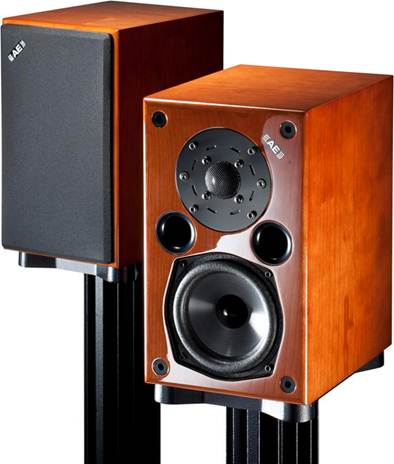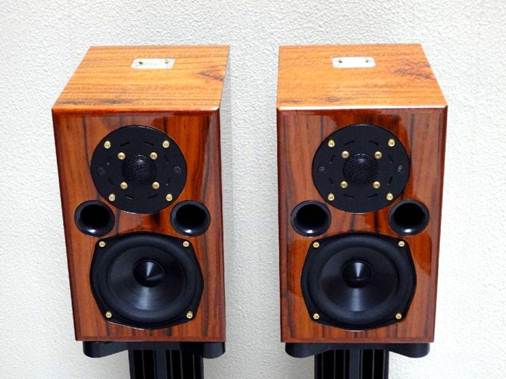In a world of large multi-driver loudspeakers, Acoustic
Energy’s AE1 laid down the blueprint for thoroughly modern mini-monitors.
The eighties was the first decade of hi-fi as we know it
today – things that are recognizably modern now began to be so in the eighties,
and this holds for loudspeakers more than any other audio separates. Back in
those heady days of Duran and the Golf GTi, hi-fi downsized – thanks in no
small part to the changing dimensions of the modern British abode. As property
prices soared, new build houses got smaller and the number of ‘Yuppie flats’
exploded. This saw a gradual shift from the sort of speakers we’d seen in the
seventies – with wide front baffles and myriad drive units – to small,
minimalist two-way stand mourners purposed to work in more compact
environments.

Acoustic Energy’s
AE1
From this change in living patterns came two iconic mini
monitors. Wharf dale’s little Diamond arrived first in 1984, and set the
template for baby boxes making great sound. But while they sounded good on the
end of a Rega and a NAD, higher-end systems were denied a great small speaker
until the arrival of the Acoustic Energy AE1 in 1987. At the height of the eighties
boom, when red brace wearing, Porsche 911 driving city traders captured the
zeitgeist, came this great symbol of hi-fi modernity. It sounded superb, and
stood for a brave new hi-fi world.
Goodbye seventies
While a handful of brilliant speakers came out of ‘the
decade that fashion forgot’, the vast majority were the exact opposite. They
were often three or four-way away, and most used rudimentary paper-coned
midrange and bass units, and relatively crude paper or fabric dome tweeters.
Polypropylene was thought an exotic cone material back then and that’s only
because it was Bextrene, which these days has been consigned to the great
speaker skip in the sky.

The AE1s were as
much of the eighties zeitgeist as Porsche’s 911
As well as archaic drivers, seventies speakers generally
sported what would today be seen as appallingly loose, resonant cabinets. Thin
chipboard was often the norm, usually not damped terribly well and only thinly
veneered with the obligatory teak wood! This was further aggravated by wide front
baffles, which did little for stereo imaging. Round the back, cheapo spring
clip connectors were standard. The result was a woolly, ponderous and diffuse
sound with low levels of transparency or insight.
Imagine then, how the arrival of the new Acoustic Energy AE1
must have felt? From this brand new English company came a strikingly small
(295x180x255mm) miniature monitor loudspeaker that broke every rule in the
book. Into the heavily damped and thick 22mm MDF-walled cabinets – finished in
the de rigger eighties crackle black – went a 25mm SEAS magnesium alloy dome
tweeter. In the eighties, metal domes were cutting edge, the sound of the
future, and there was no way the AE1 could not have one! Then, below 3 kHz, an
Acoustic Energy-designed and built 90mm ceramic sandwich aluminum alloy cone
mid/bass driver took over.

The straight-sided
cone was spun from aluminum alloy with a graded thickness across its profile
and then hard-anodized black on both sides.
The straight-sided cone was spun from aluminum alloy with a
graded thickness across its profile and then hard-anodized black on both sides.
As the anodized layers take up one third of the cone’s thickness, it was
effectively a sandwich of alumina (aluminum oxide) and aluminum, said to be
both stiffer and better damped than a pure metal. The cone shaped dust cap was
glued to the cone, which was driven by a 1.5in aluminum voice-coil former. The
mid/bass driver was reflex loaded by two front-firing 40mm ports, and fed by a
crossover mounted on the rear terminal panel – contrary to the fashion of the
day it was quite a complex third-order affair with high quality iron-dust-cored
inductors and low-loss polyester capacitors.
This all made for a quintessentially eighties mini monitor –
one with a pretty smooth frequency response from 70Hz to 22kHz (+/-3dB) and a
high power handling of 200W. But the AE1 was also an effort to drive, with a
quoted sensitivity of 86dB/1W/1m, necessitating the use of a powerful
transistor amplifier – tube amp owners need not apply! Not that this was an
issue in the eighties, as everyone thought thermionic valves had gone the way
of the dinosaur. So this was the very epitome of the modern reference monitor –
it’s hard to understate how bang up to date it looked in those distant days of
1987.